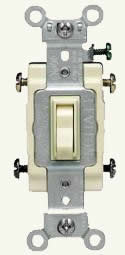
Figure 1 - 3-way switch

Figure 2 - 4-way switch
Standard electrical switches are designed to turn lights or other electrical devices "ON" and "OFF" from one location.
In many instances in a home, having the ability to turn lights or other electrical devices "ON" and "OFF" from more than one location is desirable and provides added safety and security.
Stairways are one of the most common areas in a home to utilize switches that provide "ON" and "OFF" capability from more than one location. A switch is placed at both the top and bottom of the stairwell providing added safety.
Rooms that have multiple entry and exit points are another common area for multiple switches as are long hallways. Allowing individuals to turn on lights upon entering the hallway at one end and turning the lights off, upon exiting the hallway at the other end.
3-Way switches (Figure 1) are designed to turn lights or other electrical devices "ON" and "OFF" from two locations and depending on the circuit configuration one or two 3-Way switches may be used in a circuit that turns lights or other electrical devices "ON" and "OFF" from more than two locations.
4-Way switches (Figure 2) are designed to turn lights or other electrical devices "ON" and "OFF" from three or more locations. In theory there is no limit to the amount of switches that can be installed on any one circuit.
Providing the wires and connections to make multiple switch circuits work can be confusing as the wire locations are subject to whether the live feed into the circuit is at a light fixture, electrical device or at one of the switch locations and how many devices are actually being controlled in the switching circuit.
Wiring diagrams have been provided to handle most situations. Follow the links:
Standard Switch Installation - Turning circuit "ON" and "OFF" from 1 location.
3-Way Switch Installation - Turning circuit "ON" and "OFF" from 2 locations.
4-Way Switch Installation - Turning circuit "ON" and "OFF" from 3 or more locations.
